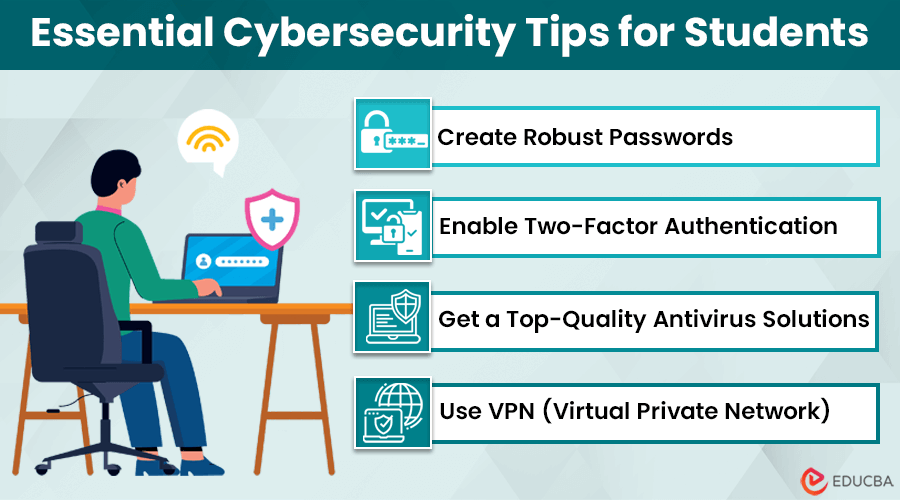
What Does Cybersecurity for Students Mean?
The internet has many educational resources and communication tools, which are changing the way students learn and connect. However, lurking beneath the surface of this online world is a web of hidden dangers. From student loan phishing scams to cyberbullying on social media, cybercriminals are increasingly exploiting the vulnerabilities students face, making cybersecurity for students an emergency.
Online safety for students is a critically important topic, but unfortunately, schools do not discuss it enough. In this article, we will explain why students are prime targets for cybercrime, provide details about essential cybersecurity, and offer practical tips to ensure that you remain safe.
Why are Students Prime Targets for Cyber Crime?
The internet has become a popular place to be. People can’t go without it. It’s simply a part of our daily lives — and that’s not changing anytime soon. However, cybercrime has existed for many years, and it’s getting more prominent by the day. Students, in particular, can be attractive targets for cybercriminals, and here’s why:
- Limited Cybersecurity Knowledge: Compared to people who have been using the internet for decades, students may have less experience with online threats. This makes them more susceptible to phishing scams, social engineering tactics, and malware attacks. It means they need a stronger foundation in cybersecurity best practices.
- Tech-Savvy but Security-Naive: Students are often comfortable using various online platforms and applications. However, they are usually not aware of the security they need to have in place to stay safe online. They may overlook suspicious messages, readily share personal information, or download apps without considering potential security risks.
- Financial Concerns and Student Loans: Cybercriminals prey on students’ financial vulnerabilities. Phishing scams often target student loan accounts, tricking them into revealing sensitive financial information or login credentials.
- Social Media Presence: Students are highly active on social media platforms, sharing personal details and engaging in online interactions. Cybercriminals can exploit this extensive online footprint for social engineering attacks, identity theft, or online harassment.
- Shared Devices and Public Wi-Fi: Students often rely on shared devices in computer labs or dorms. It can create security risks if they do not follow proper safety practices. In addition, frequent use of public Wi-Fi networks for accessing online resources exposes them to potential data theft or malware infections.
How to Use Cybersecurity for Students to Safeguard Classroom Devices?
While the internet carries inherent risks, it can be a safe space if students use it properly.
Firstly, when using shared computers in labs or libraries, always keep cyber-safe practices in mind. Log out of your accounts after each session and avoid saving personal information on these devices. Also, consider using a portable USB drive to store your work and projects. The same security principles apply to your personal devices that you use at home for schoolwork. Make sure to update your laptop or tablet with the latest security patches.
Then there’s the problem of public Wi-Fi. Avoid connecting to unsecured public Wi-Fi networks for sensitive tasks while completing assignments or accessing online resources at coffee shops or libraries. If public Wi-Fi is unavoidable, consider using a VPN to encrypt your data and minimize the risk.
You should always be wary of unfamiliar attachments. Avoid opening email attachments or downloading files, especially from unknown senders. Phishing scams often target students with seemingly legitimate attachments containing malware.
Cybersecurity for Students – Essential Tips
In a world full of hidden dangers and cybercriminals waiting at every corner, how do you stay safe at all times? It’s impossible to be vigilant at all times, but we all make mistakes. That’s why you need to use premium cybersecurity tools. Here are some tips for students to stay protected.
- Create Robust Passwords: To protect your accounts, you need to use strong and unique passwords as your first line of defense. Use a combination of letters in upper and lowercase, string of numbers, as well as several symbols, to make passwords difficult to guess or crack. However, remembering all of these passwords is impossible, so you need to use a password manager to securely store passwords for all your accounts.
- Enable Two-Factor Authentication: While you are at it, enable two-factor authentication (2FA) to add an extra layer of security. OOnce you enable 2FA, whenever you try to login, you will need to input a verification code you receive on SMS along with your password. This reduces the risk of access by cybercriminals who might have access to your password.
- Get Top-Quality Antivirus Solutions: Now, protecting your devices on another level requires some armor. Just like your physical health needs protection, so do your devices! Invest in a reputable antivirus and anti-malware software program. Update your systems with latest software’s to make sure you can detect and neutralize the online threats. Also, schedule regular scans to identify and remove any potential malware hiding on your device.
- Use a VPN (Virtual Private Network): Finally, consider using a virtual private network. A VPN adds extra security to your information, especially when using public Wi-Fi networks. A VPN encrypts your internet traffic, creating a secure route between just your device and the internet. This way, no other device can snoop on your data.
Final Thoughts
Cybersecurity for students is a crucial aspect in today’s digital education world. By following robust security features, software solutions, and excellent cybersecurity tips, students can protect themselves and their data from imminent online threats.


